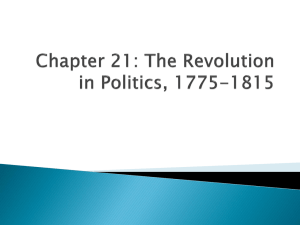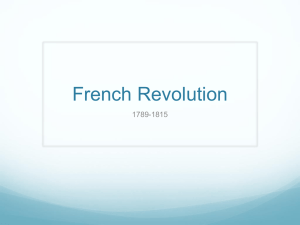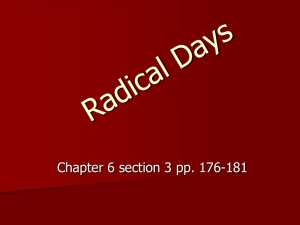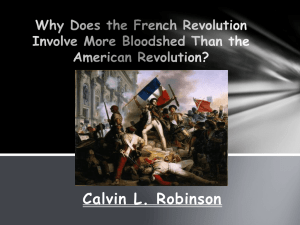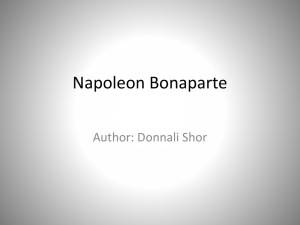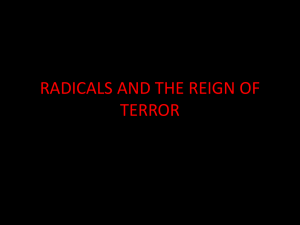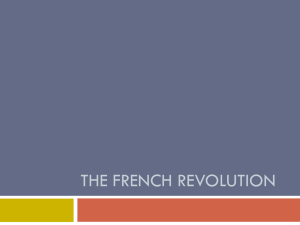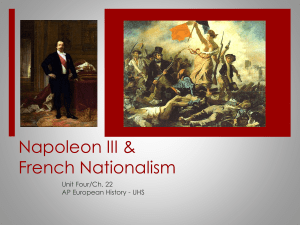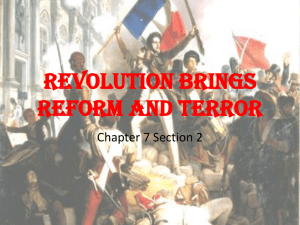Ch 21 pt 3 - Edmonds School District
advertisement
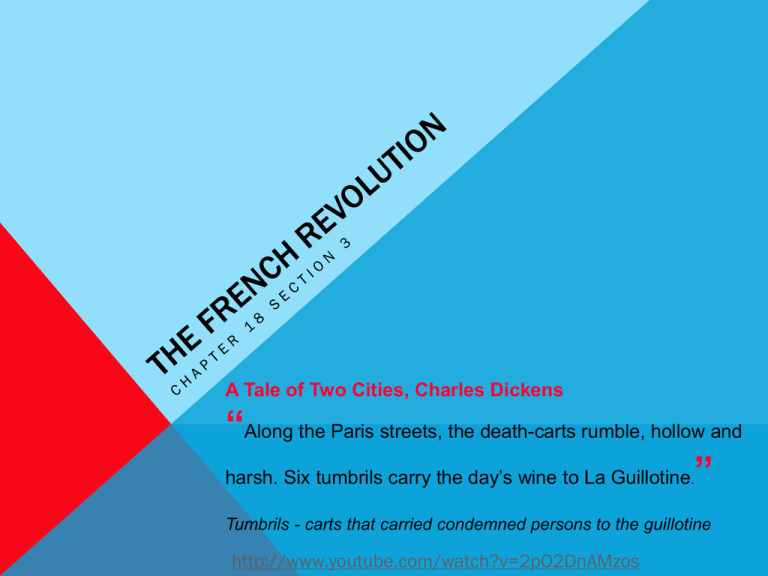
A Tale of Two Cities, Charles Dickens “Along the Paris streets, the death-carts rumble, hollow and harsh. Six tumbrils carry the day’s wine to La Guillotine ” . Tumbrils - carts that carried condemned persons to the guillotine http://www.youtube.com/watch?v=2pO2DnAMzos Learning Goals: Summarize the events that occurred during the radical phase of the French Revolution? Understand how and why radicals abolished the monarchy. Explain why the Committee of Public Safety was created and why the Reign of Terror resulted. Summarize how the excesses of the Convention led to the formation of the Directory. MARIE ANTOINETTE TRANSPORTED BY CART TO THE GUILLOTINE Analyze how the French people were affected by the changes brought about by the revolution. A LIMITED MONARCHY August 1789, the National Assembly issued a Declaration of the Rights of Man, Enlightenment philosophy: classical liberalism “Men are born and remain free and equal in rights.” The National Assembly created a constitutional monarchy with the reluctant consent of King Louis XVI. new constitution went into effect in 1791. Became the constitutional blueprint for France. Influenced by American constitutional ideas Guaranteed due process of law; a citizen was innocent until proven guilty. Sovereignty of the people. Natural rights are “liberty, property, security, and resistance to oppression.” (Locke) Law is expression of the “General Will” (Rousseau) Freedom of expression and religion. Liberty defined as freedom to do anything not injurious to others, as determined only by law. Taxes could be raised only with common consent. All public servants accountable for conduct in office. Separation of powers through separate branches. Confiscation of property from private persons had to be done with fair compensation. “Citizen” applied to all French people, regardless of class. WORLD WAR AND REPUBLICAN FRANCE, 17911799 Foreign Reactions and the Beginning of War Edmund Burke published the classic critique of the French Revolution, Reflections on the Revolution in France, in 1790. Mary Wollstonecraft published her rebuttal, A Vindication of the Rights of Man in the same year. Wollstonecraft and the Frenchwoman Olympe de Gouges argued that women should be included in the liberal ideal of equality. In the summer and fall of 1791 the Revolution was radicalized by several events. Louis XVI’s attempt to escape France Austria and Prussia’s declaration of readiness to intervene in France under certain conditions The election of a new Legislative Assembly under a new constitution By the summer of 1792 France was at war with Austria and Prussia and the Legislative Assembly had removed Louis XVI from the throne. Rights of Women • Women gained increased rights to divorce, to inherit property, and to get child support from the fathers of their illegitimate children. Drawback of Declaration of Rights: Women did not share in equal rights. Women could not vote or hold office Olympe de Gouges: The Rights of Woman, 1791 • Following official Declaration in each of its 17 articles, she applied them to women explicitly in each case. Mary Wollstonecraft in England published Vindication of the Rights of Woman in 1792. • Ideas similar to de Gouges • Madame de Stael • Ran a salon and wrote widely read books. • Deplored subordination of women to men that the Revolution had done so little to change. The Second Revolution Members of the newly elected National Convention declared France a Republic in September 1792. Revolutionaries tried to create a new revolutionary French culture. The Convention tried and executed Louis XVI on charges of treason. The sans culottes, or working people of Paris, exercised a strong influence on the Convention. TOTAL WAR AND THE TERROR Military defeats prompted the revolutionary government, led by the Committee of Public Safety, primitive sort of centrally controlled economy, fixed prices for bread, rationing, tight control of munitions industry The Terror aimed to crush all opponents of the Revolution. About 40,000 French were executed in the Terror 300,000 suspects were arrested. France mobilized a huge number (800,000) of motivated soldiers by instituting a draft and encouraging patriotic sentiment. Outnumbering their opponents by perhaps 4 to 1, France won great battlefield victories. THE THERMIDORIAN REACTION AND THE DIRECTORY, 1794-1799 The Convention, fearing the expansion of the Terror, executed Maximilien Robespierre in July 1794. A new executive, the five-man directory, ruled France from 1795-1799, essentially as dictators. The end of economic controls hit the poor in Paris hard, and resulted in riots that were suppressed by force. In rural France villagers, especially women, restored a normal, structured lifestyle, based in part on the Catholic Church. THE NAPOLEONIC ERA, 1799-1815 Napoleon’s Rule of France Napoleon confirmed the gains of the peasantry and reassured the middle class by defending property. He strengthened the central bureaucracy of France. By the Concordat of 1801 he simultaneously reinstated freedom of worship for Catholics and maintained tight control of the Church. Napoleon’s new law code reduced women’s legal and property rights. Napoleon established a police state and strict censorship to silence political dissent. Napoleon’s Wars and Foreign Policy The Treaty of Amiens with Great Britain (1802) gave France Holland, the Austrian Netherlands, the west bank of the Rhine, and most of the Italian peninsula. In May 1803 Napoleon renewed war with Britain, but his plans to invade the island were shattered by the naval battle of Trafalgar (1805). Austria, Russia, and Sweden joined Britain in the Third Coalition against Napoleon (1805). Napoleon defeated the Coalition’s continental partners. In 1806 Napoleon crushed Prussia. French occupation of much of Europe eventually produced nationalist reactions, as the conquered areas attempted to throw off French rule. In June 1812 Napoleon invaded Russia. He was defeated. Joined by Austria and Prussia, Russia and Great Britain defeated Napoleon in 1814. The victorious allies set up a constitutional monarchy in France under Louis XVIII. RADICAL DAYS OF THE REVOLUTION THE MONARCHY IS ABOLISHED The Radical Phase of the Revolution -1793, • one of the bloodiest governments in French history as leaders sought to extend and preserve the revolution. Tensions Lead to Violence French Army in trouble (the region we see today as • Prussian forces were cutting down raw French recruits Germany and Poland) • royalist officers were deserting the French army, joining others hoping to restore the king’s power. • Battle disasters • Angry revolutionaries who thought the king was in league with the enemies. August 10, 1792 • a crowd of Parisians stormed the royal palace of the Tuileries and slaughtered the king’s guards. • The royal family fled to the Legislative Assembly, escaping before the mob arrived. “September massacres.” • citizens attacked prisons that held nobles and priests accused of political offenses. • About 1,200 prisoners were killed; among them were many ordinary criminals. RADICALS TAKE CONTROL AND EXECUTE THE KING September 1792 • Radicals called for the election of a new legislative body called the National Convention. • Suffrage, the right to vote • all male citizens, not just to property owners. • abolished the monarchy and establish a republic—the French Republic. • a new constitution Jacobins were mostly middle• The Jacobins plan class lawyers or intellectuals. • remove all traces of the old order • seized lands of nobles • Abolished titles of nobility • Put Louis XVI on trial as a traitor to France. • The king was convicted and sentenced to death. • January 1793, “Frenchmen, I die innocent. I pardon the authors of my death. I pray God that the blood about to be spilt will never fall upon the head of France. . . .” • October, Marie Antoinette was also executed. TERROR AND DANGER GRIP FRANCE Early 1793 • The country was at war with much of Europe, • Britain, • the Netherlands, • Spain, • Prussia. • Vendée (vahn DAY) region of France, royalists, priests peasants rebelled against the new government. • Paris, the sans-culottes demanded help with food shortages and inflation. • The Convention was bitterly divided between Jacobins and the Girondins. THE CONVENTION CREATES A NEW COMMITTEE The Committee of Public Safety • To deal with the threats to France. • 12-member committee • almost absolute power as it battled to save the revolution. • prepared France for all-out war, • issuing a levée en masse, • or mass tax that required all citizens to contribute to the war effort. • in charge of trials and executions. ROBESPIERRE “THE INCORRUPTIBLE” Maximilien Robespierre (ROHBZ pyehr). • a shrewd lawyer and politician, Jacobin • rose to the leadership of the Committee of Public Safety. • his selfless dedication to the revolution earned him the nickname “the incorruptible.” • The enemies of called him a tyrant. Embraced Rousseau’s idea of the general will as the source of all legitimate law. • He promoted religious toleration • Wanted to abolish slavery. • “republic of virtue” only through the use of terror, • “prompt, severe, inflexible justice.” • “Liberty cannot be secured, unless criminals lose their heads.” THE GUILLOTINE DEFINES THE REIGN OF TERROR Reign of Terror, - from September 1793 to July 1794. Spectators greeted death sentences with cries of “Hail the Republic!” or “Death to the traitors!” • Revolutionary courts conducted hasty trials. • Suspect were those who resisted the revolution. • About 300,000 were arrested. • Seventeen thousand were executed. • the guillotine quickly became a symbol of horror. • Many were victims of mistaken identity or were falsely accused by their neighbors. • Many were packed into hideous prisons, where deaths from disease were common. • Weary of bloodshed and fearing for their own lives, members of the Convention turned on the Committee of Public Safety. • July 27, 1794, Robespierre was arrested. The next day he was executed. LIBERTY – EQUALITY - FRATERNITY OR DEATH • February 5, 1794, Robespierre explained why the terror was necessary to achieve the goals of the revolution: “It is necessary to stifle the domestic and foreign enemies of the Republic or perish with them. . . . The first maxim of our politics ought to be to lead the people by means of reason and the enemies of the people by terror. . . . If the basis of popular government in time of peace is virtue, the basis of popular government in time of revolution is both virtue and terror.” —Maximilien Robespierre, quoted in Pageant of Europe (Stearns THE REVOLUTION ENTERS ITS THIRD STAGE The Constitution of 1795 • Moving away from the excesses of the Convention, • moderates produced the third constitution since 1789. • The middle class and professional people of the bourgeoisie were the principal force • set up a five man Directory • two-house legislature • elected by male citizens of property. • Directory held power from 1795 to 1799. • Weak • dictatorial, • The Directory faced growing discontent. • Peace was made with Prussia and Spain, • war with Austria and Great Britain continued. • Corrupt leaders lined their pockets • failed to solve problems. • rising bread prices caused riots, • the Directory quickly suppressed them. • the renewal of royalist feeling. • émigrés were returning • devout Catholics, who resented measures that had been taken against the Church In the election of 1797, supporters of a constitutional monarchy won the majority of seats in the legislature. As chaos threatened, politicians turned to Napoleon Bonaparte a popular military hero REVOLUTION BRINGS CHANGE 1799 – 10 years of Revolution • It had removed the old social order, • overthrown the monarchy, • brought the Church under state control. New symbols • red “liberty caps” • tricolor • the liberty and equality of all male citizens. • new title “citizen” • people of all social classes. • All other titles were eliminated. • Elaborate fashions and powdered wigs gave way to the practical clothes and simple haircuts of the sans-culottes. NATIONALISM SPREADS Nationalism, a strong feeling of pride in and devotion to one’s country • Revolution and war gave the French people a strong sense of national identity • civic festivals that celebrated the nation and the revolution. • A variety of dances and songs on themes of the revolution • By 1793, France was a nation at war. • From the port city of Marseilles troops marched to a rousing new song. • It urged the “children of the fatherland” to march against the “bloody banner of tyranny.” • This song, “La Marseillaise” would later become the French national anthem. REVOLUTIONARIES PUSH FOR SOCIAL REFORM Social Reform and Religious Toleration. • state schools • replace religious ones • organized systems to help the poor, old soldiers, and war widows. • abolished slavery in France’s Caribbean colonies. • major slave revolt raging in the colony of St. Domingue (Haiti) • The 1st successful slave revolt ART OF REVOLUTION Napoleon Crossing Mont Saint Bernard, Jacques-Louis David, 1801 Imprisoned after moderates turned against the Reign of Terror, David barely escaped with his life. When Napoleon rose to power, David deftly switched his political allegiance to the new Emperor of France and became one of Bonaparte’s chief portraitists. Notice the names carved into the rocks. David included these names of great past rulers to show Napoleon’s level of greatness. David’s depictions of Napoleon helped cement him as a strong and heroic leader. THE THIRD OF MAY, 1808, FRANCISCO JOSÉ DE GOYA Y LUCIENTES, 1814 One of the consequences of the French Revolution and Napoleon’s rise was that France soon found itself at war with the rest of Europe. Francisco Goya saw first hand the impact of these wars. Born in northern Spain, he rose to become the official painter of the Spanish court. When Napoleon invaded Spain and deposed its king, Goya chronicled the horrors of the resulting guerrilla warfare. People never knew if friends or family might appear on a list of guillotine victims. There is some debate on the humaneness of death by guillotine. Some authorities claim that even after the head has been severed, the victim could remain conscious for up to 30 seconds. Georges Danton, a Revolutionary leader, challenged the Terror and was guillotined. This engraving depicts Robespierre’s Execution by guillotine. His was not the last. “Twenty minutes later, [those condemned for the day] were in front of the scaffold…. Pale, tense, shivering… several of them lowered their heads or shut their eyes…. The third [victim] was…the Princess of Monaco…. On the platform, her youthful beauty shone in the dazzling July light.” The executioners then tossed the bodies and heads into large baskets near the scaffold. VIDEOS http://www.biography.com/people/louis-xvi-9386943 http://www.history.com/topics/marie-antoinette/videos (guillotine) http://www.history.com/topics/marie-antoinette/videos/robespierre-and-the-reign-ofterror?m=528e394da93ae&s=undefined&f=1&free=false http://www.biography.com/people/marie-antoinette-9398996

